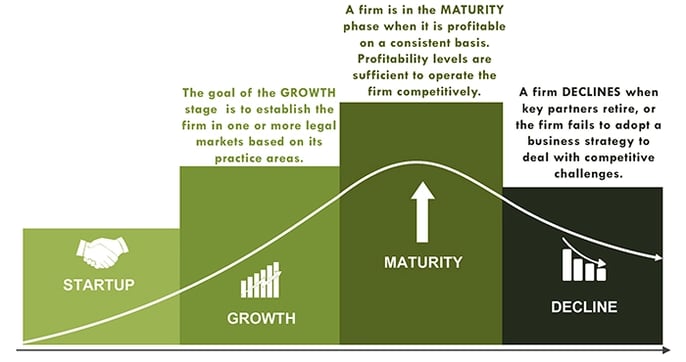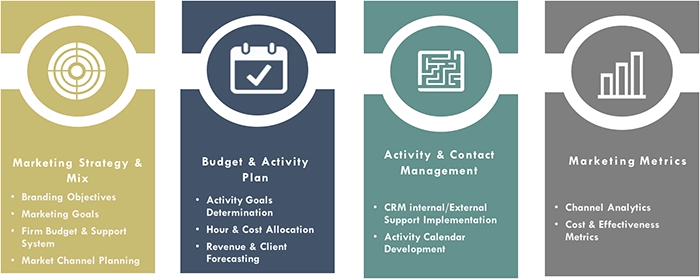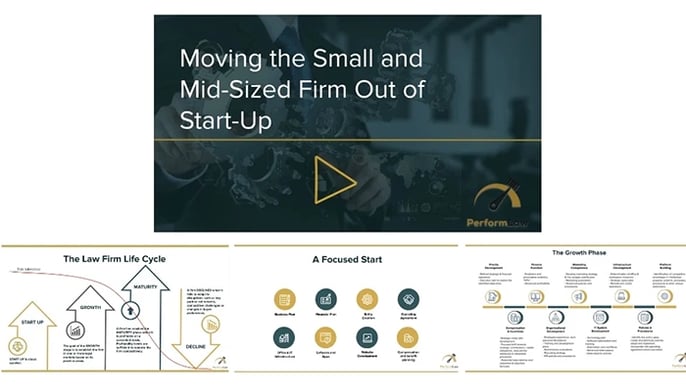The business life cycle of a small/mid-sized law firm is often significantly different from the life cycle of other industries. Product companies, for example, have a life cycle that depends on the sustainability of their existing market offerings combined with their ability to innovate and create new offerings. These companies can make long-term strategic investments, change management and, if necessary, completely remake themselves.
Conversely, most small and mid-sized law firms are tied to their equity members’ ability to practice law, originate revenues, and adapt to legal industry developments. These firms usually have little flexibility in dealing with abrupt market changes, poor management or long-term strategic plans.
Because small and mid-sized law firms are owner-operated businesses and rely on equity partners or members to generate revenue, there isn’t time for them to develop systems or pursue long-term priorities. Rarely is there a person, much less a team, whose only responsibility is managing the development of the firm.
Equity partners have little interest in investing in future initiatives that involve short-term risk and deferred profits. A 5-year aggressive growth plan is not attractive to a 60-year-old member at the top of her earnings capacity who needs her current income to max out retirement savings.
Moreover, there is no market in the United States for outside capital investment in law firms (investors seeking financial returns only). The ABA currently does not approve of any models of law firm ownership by non-lawyers. And since most young lawyers do not have the net worth to underwrite long-term strategies that may or may not pay off, senior partner net worth is a vital component of the long-term plans of small and mid-sized law firms.
For these reasons, it is easy to see why small and mid-sized law firms fixate on current profits to the detriment of longer-term goals. Rather than invest in the future, they apply all earnings to partner compensation.
While it may be surprising that small and mid-sized law firms progress at all, most firms do follow a path resembling a business life cycle. When PerformLaw works with law firms that wish to develop into better organizations, we start with the following outline to assess their position on the business life cycle and to guide our recommendations:

To firmly establish the firm in the legal market requires a growth management plan including the following components:
A Focused Start Managing Growth
As with any new company’s start-up, a law firm’s founding partner(s) should first define a vision (long-term future goal), a mission (present business approach to realize the vision), as well as initial financial and strategic objectives (to be revised over the cause of the firm’s existence).
Financial objectives focus on targeted revenues, costs, profit margins, etc. Strategic objectives are long-term competitive positioning goals. Among others, these could include market share, technological leadership, brand name value, and client satisfaction. After giving the firm its purpose, defining the law firm operational strategy is next.
This step should include the following basic elements:
- Business Plan
- Financial Plan
- Entity Creation
- Operating Agreement
- Office & IT Infrastructure
- Software and Apps
- Website Development
- Compensation and benefit planning
Since the need to generate revenue and positive cash flow is primary, some of these elements remain a work in progress after startup. Beyond billing and collections, high-level business administration develops at a slower pace and requires additional skills. Advanced skill set either come from new hires or outside resources.
Once profits occur on a consistent basis, a growth phase typically starts and requires the firm to move to a professional business management approach, which is less reliant on the firm’s equity members.
Scale and Manage Sustainable Growth
To scale and manage growth successfully, we recommend that law firms determine their projected income versus the projected expenses required to pursue their objectives. Additionally, firms should require members to consider what investments are needed to sustain and grow their revenues and profits.
These investments include operational and marketing components.
Operational investments include:
- Staffing mix,
- Infrastructure investments,
- Practice tools, and
- Systems.
Meeting these needs using a combination of in-house resources, outsourced services, and software applications is recommended.
All marketing investments include all components of a law firm's marketing plan, which are listed and displayed in the graphic below:
- Marketing Strategy
- Budget & Activity Plan
- Contact Management
- Metrics

We recommend the same approach to meet the firm’s marketing needs: a combination of in-house resources, outsourced services, and software applications.
This basic planning process and related investments should result in two major benefits:
- An operational team with clear legal and non-legal functions and responsibilities
- Brand awareness and service differentiation, resulting in a competitive advantage.
Growth Phase - PerformLaw Support
Consistent growth requires forethought and a plan for success. When PerformLaw works with clients who are in a growth phase, we typically support them in the following ways:
- Priority Development (strategic and financial)
- Compensation and Incentives (partner compensation, associate pay, bonuses)
- Financial Modeling (revenue projections, profitability reporting)
- Organizational Development (Human Resources, attorney development, training)
- Marketing Competence (opportunity analysis, budgeting)
- Infrastructure Development (office and workspace needs)
- Policies & Procedures (policy gaps and needs, policy creation)
- Platform Building (competitive advantages, intellectual property)
See the graphic below for additional details


Regardless of how a firm chooses to manage a growth phase, we highly recommend these steps to ensure sustainable organizational growth. Using this recommended approach promotes the firm’s brand, supports a healthy cost structure, and promotes the long-term stability of the law firm.
P R E S E N T A T I O N
Here is a helpful presentation that walks you through the various steps of a law firm's growth and development -
from a start-up firm to a firm that exhibits sustainable growth.
Click on the image or presentation link below to view the slides. A link to a video of us explaining each of the
slides can be found on Slide 2:
MORE HELPFUL LINKS:
.webp?width=124&height=108&name=PerformLaw_Logo_Experts3%20(1).webp)


